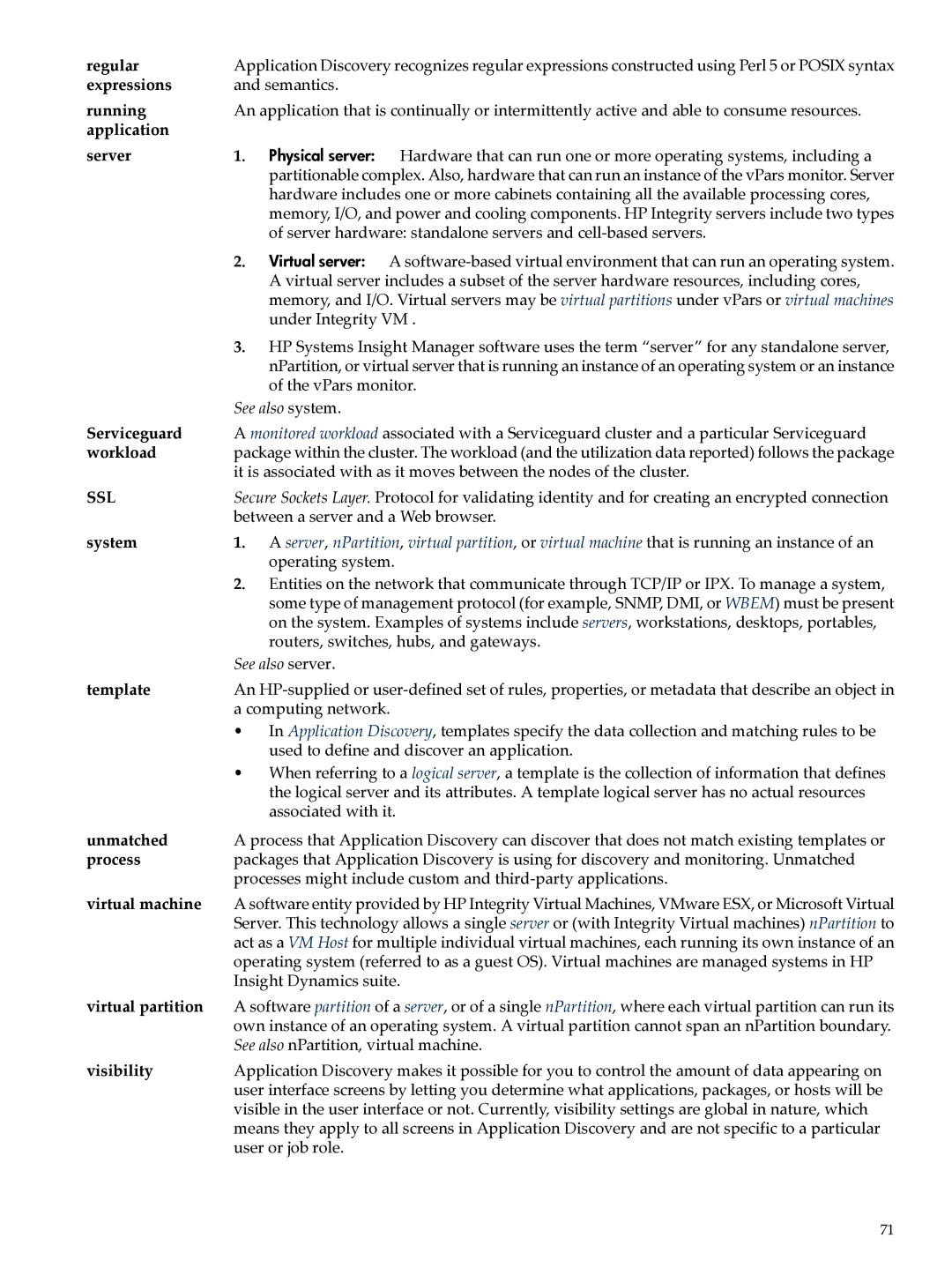regular | Application Discovery recognizes regular expressions constructed using Perl 5 or POSIX syntax | |
expressions | and semantics. | |
running | An application that is continually or intermittently active and able to consume resources. | |
application |
|
|
server | 1. | Physical server: Hardware that can run one or more operating systems, including a |
|
| partitionable complex. Also, hardware that can run an instance of the vPars monitor. Server |
|
| hardware includes one or more cabinets containing all the available processing cores, |
|
| memory, I/O, and power and cooling components. HP Integrity servers include two types |
|
| of server hardware: standalone servers and |
| 2. | Virtual server: A |
|
| A virtual server includes a subset of the server hardware resources, including cores, |
|
| memory, and I/O. Virtual servers may be virtual partitions under vPars or virtual machines |
|
| under Integrity VM . |
| 3. | HP Systems Insight Manager software uses the term “server” for any standalone server, |
|
| nPartition, or virtual server that is running an instance of an operating system or an instance |
|
| of the vPars monitor. |
| See also system. | |
Serviceguard | A monitored workload associated with a Serviceguard cluster and a particular Serviceguard | |
workload | package within the cluster. The workload (and the utilization data reported) follows the package | |
| it is associated with as it moves between the nodes of the cluster. | |
SSL | Secure Sockets Layer. Protocol for validating identity and for creating an encrypted connection | |
| between a server and a Web browser. | |
system | 1. | A server, nPartition, virtual partition, or virtual machine that is running an instance of an |
|
| operating system. |
| 2. | Entities on the network that communicate through TCP/IP or IPX. To manage a system, |
|
| some type of management protocol (for example, SNMP, DMI, or WBEM) must be present |
|
| on the system. Examples of systems include servers, workstations, desktops, portables, |
|
| routers, switches, hubs, and gateways. |
| See also server. | |
template | An | |
| a computing network. | |
| • | In Application Discovery, templates specify the data collection and matching rules to be |
|
| used to define and discover an application. |
| • | When referring to a logical server, a template is the collection of information that defines |
|
| the logical server and its attributes. A template logical server has no actual resources |
|
| associated with it. |
unmatched | A process that Application Discovery can discover that does not match existing templates or | |
process | packages that Application Discovery is using for discovery and monitoring. Unmatched | |
| processes might include custom and | |
virtual machine | A software entity provided by HP Integrity Virtual Machines, VMware ESX, or Microsoft Virtual | |
| Server. This technology allows a single server or (with Integrity Virtual machines) nPartition to | |
| act as a VM Host for multiple individual virtual machines, each running its own instance of an | |
| operating system (referred to as a guest OS). Virtual machines are managed systems in HP | |
| Insight Dynamics suite. | |
virtual partition | A software partition of a server, or of a single nPartition, where each virtual partition can run its | |
| own instance of an operating system. A virtual partition cannot span an nPartition boundary. | |
| See also nPartition, virtual machine. | |
visibility | Application Discovery makes it possible for you to control the amount of data appearing on | |
| user interface screens by letting you determine what applications, packages, or hosts will be | |
| visible in the user interface or not. Currently, visibility settings are global in nature, which | |
| means they apply to all screens in Application Discovery and are not specific to a particular | |
| user or job role. | |
71
